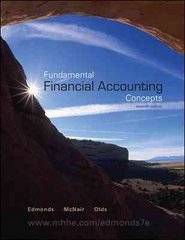Question
MBA 803 - Homework #4 Capital Budgeting 1)You are a manager at Advanced Plastics, which is considering expanding its operations into 3D manufacturing. Your boss
MBA 803 - Homework #4
Capital Budgeting
1)You are a manager at Advanced Plastics, which is considering expanding its operations into 3D manufacturing. Your boss comes into your office, drops a consultant's report on your desk, and complains, "We owe these consultants $1.5 million for this report, and I am not sure their analysis makes sense. Before we spend the $30 million on new equipment needed for this project, look it over and give me your opinion." You open the report and find the following estimates (in thousands of dollars):
Year 1
Year 2
...
Year 9
Year 10
Sales
$40,000
$40,000
...
$40,000
$40,000
- COGS
$28,000
$28,000
...
$28,000
$28,000
= Gross Profit
$12,000
$12,000
...
$12,000
$12,000
- General and Admin. Exp.
$3,000
$3,000
...
$3,000
$3,000
- Depreciation
$3,000
$3,000
...
$3,000
$3,000
= Net Operating Income
$6,000
$6,000
...
$6,000
$6,000
- Taxes
$2,400
$2,400
...
$2,400
$2,400
Net Income
$3,600
$3,600
...
$3,600
$3,600
All of the estimates in the report seem correct. You note that the consultants used straight-line depreciation for the new equipment that will be purchased today (year 0), which is what the accounting department recommended. The report concludes that because the project will increase earnings by $3.6 million per year for 10 years, the project is worth $36 million, more than the cost of the equipment required. You think back to your halcyon days in finance class and realize there is more work to be done!
First, you note that the consultants have not factored in the fact that the project will require $15 million in working capital up-front (year 0), which will be fully recovered in year 10. Next, you see they have attributed $3 million of general and administrative expenses to the project, but you know that $2 million of this amount is overhead that will be incurred even if the project is not accepted. Finally, you know that accounting earnings are not the right thing on which to focus.
Given the available information, calculate the free cash flows for the proposed project and estimate its value using a 16 percent weighted average cost of capital. Should your firm undertake this project?
2)One year ago, your company purchased a machine used in manufacturing for $120,000. You have learned that a new machine is available that offers many advantages; you can purchase it for $200,000 today. It will be depreciated on a straight-line basis over 5 years, after which it has no salvage value. You expect that the new machine will produce EBITDA (earnings before interest, taxes, depreciation, and amortization) of $100,000 per year for the next 5 years. The current machine is expected to produce EBITDA of $45,000 per year. The current machine is being depreciated on a straight-line basis over a useful life of 6 years, after which it will have no salvage value, so depreciation expense for the current machine is $20,000 per year. All other expenses of the two machines are identical. The market value today of the current machine is $80,000. Your company's tax rate is 45%, and the opportunity cost of capital for this type of equipment is 12%. Is it profitable to replace the year-old machine?
3)Yoder Technologies is considering expanding its production capacity by purchasing a new machine, the TB-2000. The cost of the TB-2000 is $3 million. Unfortunately, installing this machine will take several months and will partially disrupt production. The firm has just completed a $50,000 feasibility study to analyze the decision to buy the TB-2000, resulting in the following estimates:
Marketing: Once the TB-2000 is operating next year, the extra capacity is expected to allow for $12 million per year in additional sales, which will continue for the 10-year life of the machine.
Operations: The disruption caused by the installation will decrease sales by $4 million this year. The cost of goods for the products produced by the TB-2000 is expected to be 75% of their sale price, the same as with existing equipment. The increased production will require additional inventory on hand of $2 million to be added in year 0 and depleted in year 10.
Human Resources: The expansion will require additional sales and administrative personnel at a cost of $1.5 million per year.
Accounting: The TB-2000 will be depreciated via the straight-line method over the 10-year life of the machine. The firm expects receivables from the sales to be 10 percent of revenues and payables to be 15 percent of the cost of goods sold. Billingham's marginal corporate tax rate is 40 percent. For simplicity, assume that any changes in payables and receivables begin in year 1 and are closed out at the end of year 10.
If the appropriate cost of capital for the expansion is 15 percent, calculate the incremental free cash flows associated with installing the TB-2000 and compute the NPV and IRR of the project. Should Yoder Technologies purchase this new machine?
Step by Step Solution
There are 3 Steps involved in it
Step: 1

Get Instant Access to Expert-Tailored Solutions
See step-by-step solutions with expert insights and AI powered tools for academic success
Step: 2

Step: 3

Ace Your Homework with AI
Get the answers you need in no time with our AI-driven, step-by-step assistance
Get Started


